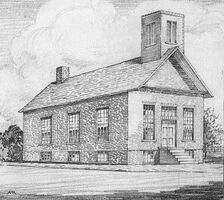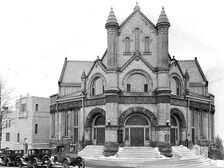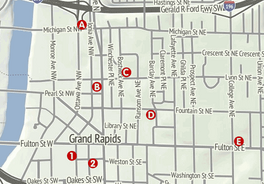
First Reformed Church, 1842-1872
First Reformed Church of Grand Rapids was begun in 1840. It gave birth to Second Reformed in 1850 and united with Second to form Central Reformed in 1918.
Beginnings
The first Reformed Church in Grand Rapids, Michigan, began when Rev. Hart E. Waring, commissioned by the Domestic Mission Board of the Reformed Church as a "western" missionary, came to Grand Rapids in May 1840. The first worship service was held on May 26, 1840, and the congregation officially organized on August 12, 1840 with 12 members.

Village of Grand Rapids in 1836, from Baxter's History of Grand Rapids
This was two years after the village of Grand Rapids had incorporated. The small village existed exclusively on the east bank of the Grand River, bounded by Hastings Street on the north, Ransom Street on the east, Fulton Street on the south, and Canal Street (now Monroe Avenue) and the Grand River on the west.
According to Daniel L. Ballast, who wrote a history of the congregation, First was created as part of the "Western Enterprise" of the Reformed Church, a program that planted new congregations where Dutch Reformed folk had settled during the western expansion (Michigan was "the West" back then). Most of these churches did not thrive, and Ballast notes that First was struggling for survival from its beginning.
First was organized as an English-speaking Dutch Reformed congregation six years before Albertus van Raalte would lead Dutch immigrants to found Holland, Michigan. For most of its first year, First Reformed held services in the village schoolhouse, and the congregation's rapid growth lead the Consistory to purchase land at the southwest corner of Bridge and Ottawa in January 1842.
In his History of Grand Rapids, Baxter notes that the Dutch Reformed Church laid a cornerstone at the corner of Bridge and Ottawa in May 1842, and that while the building was used for worship and school. The structure was build of Grand River limestone, but it was never completed due to lack of funds. The church began to use its basement in the fall of 1842. The village's population was estimated at 1,000 at this time.
When immigrants from Holland, Michigan, moved to Grand Rapids, the church welcomed them and shared its facilities as they established their own Dutch-language congregation, Second Reformed. From 1840 until 1886, First was the only English-language Reformed church in the city, which worked to its benefit as immigrants began to see it as desirable for their children to learn English and become Americanized, which brought about a rebirth for the one failing church.
After Rev. Ander B. Taylor resigned his pastorate in Sept. 1848, "seeing no signs of promise for the future of the church", the membership dropped to 33 and the congregation officially dissolved. The congregation relaunched in December 1859 to preserve its property, and it officially reorganized in July 1860, once again with 12 members, too small to continue using its large building.
During the Civil War, the church leased its building to the federal government for use as a hospital. The church returned to its property twoard the end of 1866, installed its first organ in 1867, and called its first pastor (until then, it had been served by missionaries) in 1868. The church building burned during the night of May 3, 1872, and for 1-1/2 years its members worshipped with Westminister Presbyterian Church.

First Reformed Church, 1895-1918
The Consistory sold the old property in February 1873 and bought the Baptist church building on Fountain Street. This building had a seating capacity of 420, and the congregation soon outgrew its new facilities. First Reformed became financially self-sustaining in 1880, and in April 1888 it bought land at Fountain and Barclay for a new buidling, which was completed in 1895.
First merged with Second in 1918 to form Central Reformed.
Historical Details

Downtown locations of First Reformed, Second Reformed, and First Christian Reformed churches.
Locations
First Reformed was located at the corner of Michigan and Ottawa NW (A on map) from 1842 to 1872. After this building burned, it moved to the west side of Division between Pearl and Lyon (B), currently the Waters Building, where it remained from 1872 until 1891. Its third and final location was 164 Fountain Street NE (D), where it remained until it merged with Second to form Central Reformed (E) in 1918.
Pastors
- Hart E. Warring, missionary, 1840-43
- Andrew B. Taylor, supply, 1843-48
- John M. Ferris, 1862-65
- H. Decker, 1865-67
- Christian Van Der Veen, 1868-70
- Jacob Van de Meulen, 1871-72
- Peter Moerdyke, 1873-92
- William H. Williamson, 1892-99
- John M. Van der Meulen, 1899-1901
- Gustavus A. Watermulder, 1903-05
- John A. Brown, 1907-18
Daughter Churches
- Second (merged with First to form Central), 1850-1918
Membership Overview
First Reformed experienced steady growth until the early 1870s, when second-generation Dutch immigrants who spoke English flocked to it in huge numbers. Membership grew until the late 1880s, but First was still a small congregation in comparison to Dutch language Reformed churches.
Drop in membership in 1890s corresponds with formation of other English speaking Reformed congregations in Grand Rapids:
- Bethany, 1893, about one mile east of First
- Grace, 1897, about 2 miles south of First
- Bethel, 1906, about 2-1/2 miles north of First
Other congregations either adding English-language services or switching completely to English may also be a factor, but First essentially surrounded itself with English speaking churches, which put an end to church growth.
Due to incomplete reporting, nonprofessing and total membership figures 1860-78, 1898-1908, and 1910-17 are estimated.
Overall Membership Data

Membership statistics, First Reformed Church, Grand Rapids, MI
Green (lower) line shows membership in families; blue (middle), professing members; red (top), total members; and magenta (thin), non-professing members. Note: 1st and 2nd Reformed charts cover 1860-1980, not 1880-2000 as in other charts.

Membership ratios, First Reformed Church, Grand Rapids, MI
Youth Ratio
Red line shows nonprofessing members as a percentage of total membership (inactive members exluded).

Five year growth rate, First Reformed Church, Grand Rapids, MI
Five Year Growth Rate
Red line shows five year growth rate. A five year growth rate between 10% and -10% is considered stable; greater than 10% indicates a growing congregation; one below -10% indicates a church in decline. This makes no allowance for daughter churches.
Data source: Acts of Synod of the Reformed Church in America. Dates are year prior to publication date since data is gathered at the end of one year and published in the next.
Sources
- History of the City of Grand Rapids, Michigan , Albert Baxter, 1891. Especially the section on First Reformed Church